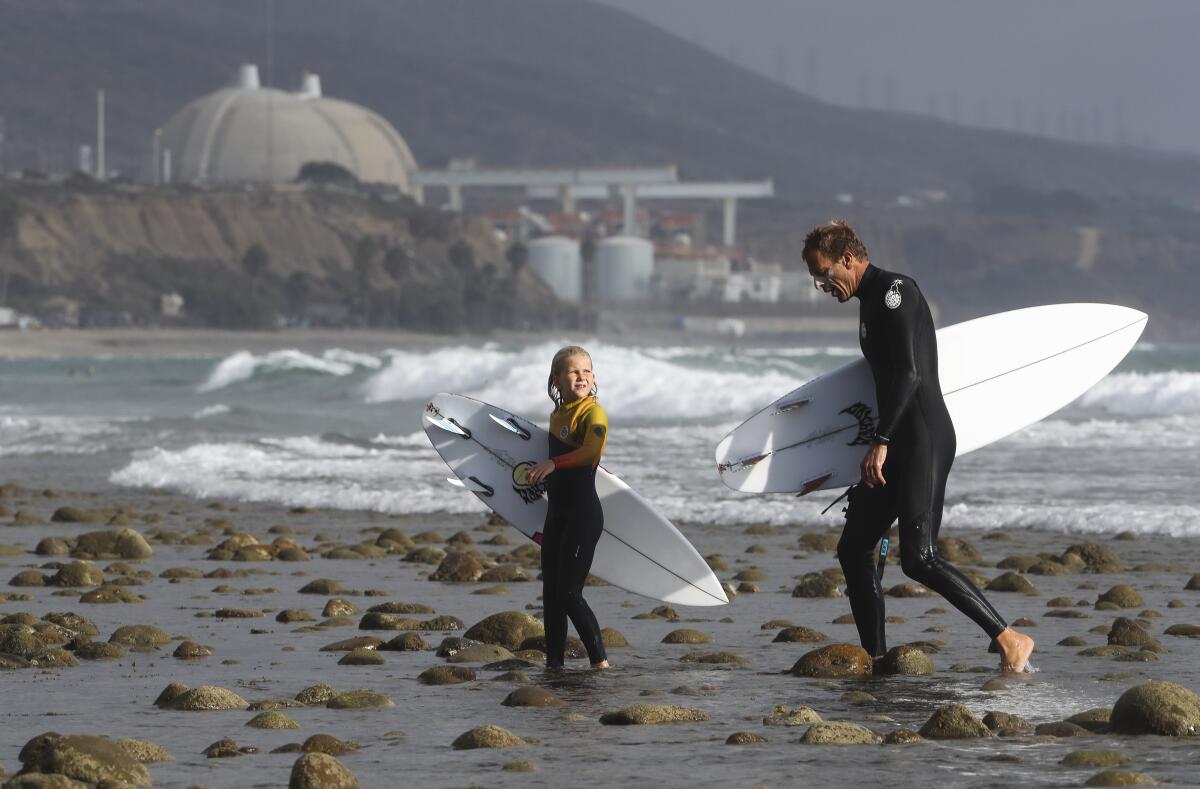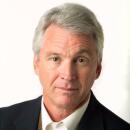How safe is the water off the coast of the San Onofre nuclear plant?

Surfrider teams with Woods Hole Oceanographic Institute to conduct their own tests of San Onofre’s radioactive wastewater
- Share via
SAN ONOFRE — Though many may not know it, throughout its existence the San Onofre Nuclear Generation Station has discharged wastewater that contains very low levels of radiation.
All nuclear plants release some effluents, though the nature and amounts can vary by plant site and configuration. In the case of San Onofre, the “liquid batch releases” go right into the Pacific.
Southern California Edison, the plant’s operator, insists the levels are safe for marine life and the humans who swim and surf at San Onofre State Beach.
But the Surfrider Foundation just announced a collaboration with the Woods Hole Oceanographic Institution in Massachusetts to double-check the water quality surrounding the now-shuttered plant to provide an extra layer of transparency.
“All the reporting and testing right now is done by Edison,” said Katie Day, staff scientist for the foundation based in San Clemente. “It’s good to be able to have an external, independent testing option, just to be a watchdog and clarify the true level and have more confidence in what the exposure is.”
Just like any other industrial operator, Edison officials must acquire permits to spit out wastewater from the nuclear plant, known as SONGS for short. Traveling through long conduits, the wastewater at San Onofre is sent more than one mile offshore and about 50 feet below the surface.
Nonradiological releases, such as sewage, have to meet the standards set by the National Discharge Pollutant Elimination System, which is implemented by the State Water Resources Control Board. Radiological discharges are governed by the license SONGS has with the federal government’s Nuclear Regulatory Commission.
In each case, the wastewater must be cleaned up and highly diluted before going into the ocean.
When the plant generated electricity, discharges from SONGS were common, since water plays an important role in operating a nuclear plant by cooling and shielding the facility from radiation. From 2000 through 2011, SONGS averaged 171 releases per year.
SONGS officially shut down in June 2013, and earlier this year, Edison and its contractors began an estimated eight-year project to tear down the facility. As part of the decommissioning effort, SONGS restarted its water batch releases in December 2019.
The number of releases and the amount expelled from the plant has sharply increased this year as dismantling activities ramped up.
Between May and mid-October, about 19,000 gallons were discharged into the ocean 11 separate times. The amount jumped to 92,200 gallons for discharges on Oct. 22-23 and Oct. 29-30. Another release came on Nov. 19, totaling more than 84,000 gallons.
Edison officials say the radioactivity of the discharges remained low and within regulatory limits. Even the more recent discharges that expelled significantly more volume contained smaller radiological doses, the company said.
The NRC has set a safe dose rate limit of 6 millirems per year. Edison says it has reached just a fraction of that limit — 0.226%.
Surfrider urged state regulators to require Edison to make public each time it makes a discharge. As part of acquiring the necessary permit in 2019 from the California Coastal Commission to start dismantling the plant, the company now posts the dates, volume and radiation dose of each liquid batch release.
“We were really excited to get that,” Day said. “Right now, San Onofre is the only nuclear plant in the United States that provides these notifications.”
Not surprisingly, word of the radiological batch releases raised alarm in some quarters. A few activists have put up signs at San Onofre State Beach, alerting surfers and beachgoers when discharges are scheduled.
SONGS shut down prematurely after ill-designed steam generators led to a radiation leak and in 2018 a 50-ton canister filled with spent fuel nearly fell about 18 feet while being lowered into a storage cavity.
Ken Buesseler, senior scientist at the Woods Hole Oceanographic Institution and an expert who has tracked radiation levels from the Fukushima nuclear disaster, said the 2019 data from the San Onofre batch releases indicated current dose levels do not pose a health threat.
“You could still swim or surf every single day for an entire year and the dose effect of the additional radiation is about a thousand times smaller than a dental X-ray,” Buesseler said of the levels of Cesium-137, a radioactive isotope his lab measures using ultra-sensitive equipment.
In fact, Buesseler said, “As a research scientist, I can detect radioactivity everywhere in every ocean, every lake, every drinking water source.”
Ever since testing of nuclear weapons began in the 1950s, Buesseler said, “we’ve been releasing radioactivity to the environment. ... Sometimes this is confusing to the public. With the methods we use, we will detect Cesium in every ocean in the world at some small level.”
In the aftermath of Fukushima, Buesseler and his team created a program called “Our Radioactive Ocean,” in which anyone can send in water samples for testing.
“People simply collect five gallons of seawater — that’s the sample size we need to measure what is there already — and then we can compare that to prior samples in the area to see if it’s elevated,” he said.
That’s exactly what Surfrider plans to do.
Now that 48 hours’ notice is given for batch releases at San Onofre, Surfrider intends to collect water samples before, during and after a discharge and send them to Buesseler’s team. Then, they can compare the numbers with the figures SONGS has released.
“Surfrider is excited to really get to learn more and partner with true experts, independent experts, in the field to have a better understanding of what our risks are,” Day said.
Officials with Edison, also known as SCE, said they see no problem with Surfrider’s plans.
“SCE has been safely cleaning and discharging these liquids for more than 50 years with no measurable impact on the environment,” Edison spokesman John Dobken said in an email. “SCE shares its science-based testing data with the public and welcomes similar science-based studies to help in educating our community about these safe releases.”
Buesseler said he avoids using the word “safe” when it comes to talking about radiation, preferring to use the term “relative risk.”
“I’ve never seen evidence of an increase [in Cesium] related to reactor operations” at San Onofre, he said. “But we should look.”
Nikolewski writes for the San Diego Union-Tribune.
More to Read
Sign up for Essential California
The most important California stories and recommendations in your inbox every morning.
You may occasionally receive promotional content from the Los Angeles Times.










